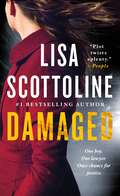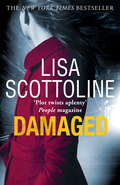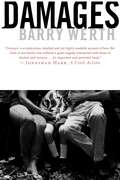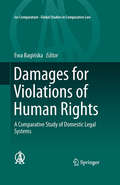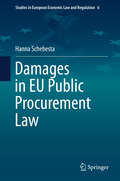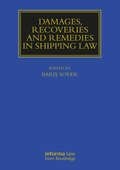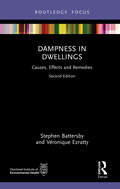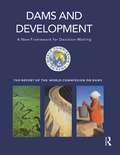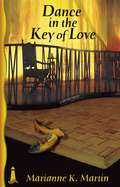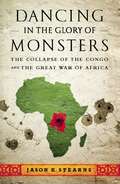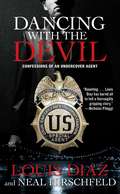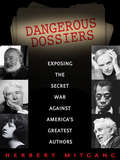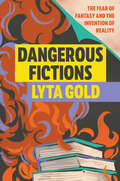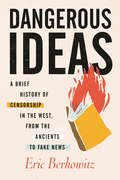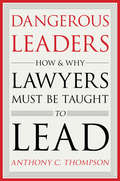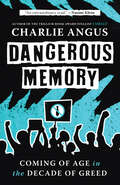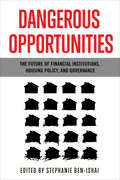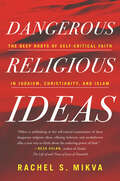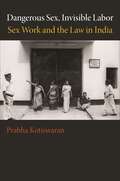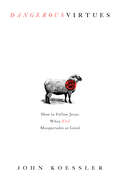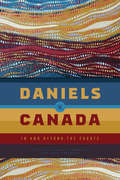- Table View
- List View
Damaged: A Rosato & DiNunzio Novel (A\rosato And Dinunzio Novel Ser. #4)
by Lisa Scottoline"Scottoline writes riveting thrillers that keep me up all night, with plots that twist and turn." -Harlan CobenOne boy. One lawyer. One chance for justice.Ten-year-old Patrick O'Brien is a natural target at school. Shy, dyslexic, and small for his age, he tries to hide his first-grade reading level from everyone: from his classmates, from the grandfather who cares for him, and from the teachers who are supposed to help him. But the real trouble begins when Patrick is accused of attacking a school aide. The aide promptly quits and sues the boy, his family, and the school district. Patrick's grandfather turns to the law firm of Rosato & DiNunzio for help and Mary DiNunzio is on the case. Soon Mary becomes Patrick's true champion and his only hope for security and justice. But there is more to the story than meets the eye and Patrick might be more troubled than he seems. With twists at every turn and secrets about the family coming to light, Mary DiNunzio might have found the case that can make her a true protector, or break her heart...With Lisa Scottoline's trademark emotional depth and fast-paced action, Damaged will have readers riveted to the last page as they root for the beloved characters and their fight for justice.
Damaged: A Rosato And Dinunzio Novel (Rosato & DiNunzio #4)
by Lisa ScottolineFrom the bestselling author of BETRAYED and CORRUPTED, DAMAGED is the fourth legal thriller in Lisa Scottoline's electrifying Rosato & Di Nunzio series. Perfect for fans of Lynda La Plante and Michael Connelly. One boy. One lawyer. One chance for justice.Shy, dyslexic and small for his age, ten-year-old Patrick O'Brien is a natural target at school. But when Patrick is accused of attacking a school aide, the tables are turned, and the aide promptly sues the boy, his family, and the school district. Patrick's grandfather turns to the lawyers of Rosato & DiNunzio for help and Mary DiNunzio is soon on the case. But there is more to the story than meets the eye and Patrick may be more troubled than he seems.With twists at every turn and secrets about the family coming to light, Mary DiNunzio might have found the case that can make her a true protector, or break her heart...
Damages
by Barry WerthDamages is the riveting true story of one family’s legal struggles in the world of medicine. At the urging of a friend, the Sabias filed a medical malpractice lawsuit against Dr. Humes and Norwalk Hospital. Barry Werth takes us through the seven-year lawsuit, allowing us to see the legal strategy plotted by the Sabias’s attorneys, Connecticut’s premier medical malpractice law firm.
Damages for Violations of Human Rights: A Comparative Study of Domestic Legal Systems (Ius Comparatum - Global Studies in Comparative Law #9)
by Ewa BagińskaThis volume analyses the legal grounds, premises and extent of pecuniary compensation for violations of human rights in national legal systems. The scope of comparison includes liability regimes in general and in detail, the correlation between pecuniary remedies available under international law and under domestic law, and special (alternative) compensation systems. All sources of human rights violations are embraced, including historical injustices and systematical and gross violations. The book is a collection of nineteen contributions written by public international law, international human rights and private law experts, covering fifteen European jurisdictions (including Central and Eastern Europe), the United States, Israel and EU law. The contributions, initially prepared for the 19th International Congress of Comparative law in Vienna (2014), present the latest developments in legislation, scholarship and case-law concerning domestic causes of action in cases of human rights abuses. The book concludes with a comparative report which assesses the developments in tort law and public liability law, the role of the constitutionalisation of the right to damages as well as the court practice related to the process of enforcement of human rights through monetary remedies. This country-by-country comparison allows to consider whether the value of protection of human rights as expressed in international treaties, ius cogens and in national constitutional laws justifies the conclusion that the interests at stake should enjoy protection under the existing civil liability rules, or that a new cause of action, or even a whole new set of rules, should be created in national systems.
Damages in EU Public Procurement Law (Studies in European Economic Law and Regulation #6)
by Hanna SchebestaThe book surveys the enforcement of EU law through the lens of damages claims for violations of EU public procurement rules. The first part clarifies the requirements on damages claims under both public procurement and general EU law, notably the public procurement remedies directives and doctrines such as procedural autonomy, effective judicial protection and Member State liability. The second part focuses on comparative law, covering England, France, Germany and the Netherlands, and provides an overview of national regulation and case law of damages litigation in the area of public procurement. A third part discusses the constitutive and quantification criteria of the damages remedy from a comparative and EU law perspective. It explores the lost chance, which functionally emerges as a compromise capable of mitigating the typically problematic nature of causation and uncertainty in public procurement constellations. The book concludes with a proposal for legislative intervention regarding damages in public procurement.
Damages, Recoveries and Remedies in Shipping Law (Maritime and Transport Law Library)
by Andrew Tettenborn Bariş SoyerThis edited volume brings together contributions from experienced academics and practitioners in shipping law to consider the crucial subject of remedies in shipping litigation. The collection takes a close look at the established principles and recent legal, commercial and technical developments in the area of remedies in shipping law. It is divided into three parts. The first part focuses on fundamental common law principles concerning damages, including approaches to topics such as damages for delay and what happens when a charter is thrown over early; the reflective loss rule; mitigation; and the problem of cryptocurrency. The second part considers technology and how it affects contracts and remedies, including the use of new technologies and the development of new liability regimes. The third part explores contractual remedies other than simple compensatory damages, considering issues such as limitation of liability, punitive damages, specific remedies, third party claims and liabilities, and anti-suit injunctions. Written for lawyers and administrators not only in England and Wales but worldwide (especially Germany, Switzerland, Greece, Canada, Australia, New Zealand, China, Hong Kong, Singapore and India), the book will also be of interest to specialist maritime law firms in the USA. It will be a valuable addition to specialist law libraries within Europe and the USA, and to university libraries where maritime and shipping law are taught as specialist subjects.
Dampness in Dwellings: Causes, Effects and Remedies (Routledge Focus on Environmental Health)
by Stephen Battersby Véronique EzrattyThis revised and updated book provides a definition of dampness in each of its forms; it details the various potential sources and causes that can result in damage to the building and damage to the health of the occupiers. It is both practical and provides an outline of the possible solutions, looking at aspects of building design and construction that can reduce or avoid the risk of dampness. It also discusses why dampness is a risk to the health of occupiers and so justifies the need to protect health by reducing or removing it.This book: Provides a valuable resource for housing, legal, and medical professionals Discusses possible solutions in aspects of building design and construction that can reduce or avoid the risk of dampness and also the safe removal of mould Provides an explanation of the legal framework in the UK and potential legal remedies for adverse health effects as a result of dampness The new edition of Dampness in Dwellings includes expanded details on the health implications of dampness in the home, legal updates, and new thinking in the wake of the tragic death of Awaab Ishak. It provides a pivotal resource for active professionals in housing, medical, and legal sectors.
Dams and Development: A New Framework for Decision-making - The Report of the World Commission on Dams
by World Commission DamsBy the year 2000, the world had built more than 45,000 large dams to irrigate crops, generate power, control floods in wet times and store water in dry times. Yet, in the last century, large dams also disrupted the ecology of half the world's rivers, displaced tens of millions of people from their homes and left nations burdened with debt. Their impacts have inevitably generated growing controversy and conflicts. Resolving their role in meeting water and energy needs is vital for the future and illustrates the complex development challenges that face our societies. The Report of the World Commission on Dams: - is the product of an unprecedented global public policy effort to bring governments, the private sector and civil society together in one process - provides the first comprehensive global and independent review of the performance and impacts of dams - presents a new framework for water and energy resources development - develops an agenda of seven strategic priorities with corresponding criteria and guidelines for future decision-making. Challenging our assumptions, the Commission sets before us the hard, rigorous and clear-eyed evidence of exactly why nations decide to build dams and how dams can affect human, plant and animal life, for better or for worse. Dams and Development: A New Framework for Decision-Making is vital reading on the future of dams as well as the changing development context where new voices, choices and options leave little room for a business-as-usual scenario.
Dance in the Key of Love
by Marianne K. MartinPaige Flemming is on the run. From the police, from her history, and from love itself. After sixteen years looking over her shoulder, she realizes it's time to run again. But when she pauses in her headlong flight to catch her breath with old friends, she crashes straight into another ghost from her past. And this time, it's not one she can easily escape.Marissa Langford is a woman living with the wreckage of her dreams. A dancer deprived of the dance by a tragic accident, she is struggling to rebuild her life when Paige's appearance rekindles bitter memories of what she has lost. For both women, their meeting asks more questions than either can readily answer.As they struggle with the turbulent emotions each provokes in the other, the net is closing on Paige. But cops are human too, and the hunter who has Paige in his sights has his own harsh emotional lessons to learn.As old secrets emerge from the darkness, this finely drawn cast of characters search deep inside themselves for the resources to battle their demons. Desire walks hand in hand with betrayal, love is held hostage by abuse and shadows threaten dreams every step of the way.In this long-awaited sequel to the best-selling lesbian romance Dawn of the Dance, Lambda Literary Award finalist Marianne K. Martin reminds us that there's no footwork fancy enough to dance out of the shadow of the past.
Dancing in the Glory of Monsters
by Jason StearnsAt the heart of Africa is Congo, a country the size of Western Europe, bordering nine other nations, that since 1996 has been wracked by a brutal and unstaunchable war in which millions have died. And yet, despite its epic proportions, it has received little sustained media attention. In this deeply reported book, Jason Stearns vividly tells the story of this misunderstood conflict through the experiences of those who engineered and perpetrated it. He depicts village pastors who survived massacres, the child soldier assassin of President Kabila, a female Hutu activist who relives the hunting and methodical extermination of fellow refugees, and key architects of the war that became as great a disaster as--and was a direct consequence of--the genocide in neighboring Rwanda. Through their stories, he tries to understand why such mass violence made sense, and why stability has been so elusive. Through their voices, and an astonishing wealth of knowledge and research, Stearns chronicles the political, social, and moral decay of the Congolese State.
Dancing with the Devil: The True Story of an Undercover Agent's War on Crime
by Louis Diaz Neal HirschfeldIN AMERICAN GANGSTER, THE FEDS TOOK DOWN INFAMOUS HEROIN DEALER FRANK LUCAS. BUT THE KINGPIN BEHIND LUCAS'S CRIMINAL REIGN, LEROY "NICKY" BARNES, REMAINED "MR. UNTOUCHABLE." UNTIL ONE UNDERCOVER AGENT PROVED TOUGH ENOUGH--OR CRAZY ENOUGH--TO INFILTRATE HIS DOMAIN AND NAIL THE MOST DANGEROUS DRUG CZAR IN AMERICAN HISTORY. Growing up in Red Hook, Brooklyn, where physical violence was a daily reality at home, at school, and on the streets, Louis Diaz had what it took to survive--and to one day become what he vowed to be: a man of uncompromising principles who is "compassionate on the inside, fierce on the outside." These were the qualities, along with his street fighter's steely nerves and hair-trigger temper, that drove Diaz from his savage beginnings and early forays in organized crime to become one of the DEA's bravest undercover agents--the man who was instrumental in taking down some of the nation's and the world's most notorious crime rings. In an unforgettable and utterly engaging first-person narrative, Diaz tells his gritty, colorful, painful, and even humorous life story--a story with all the raw emotional power and bare-knuckle action of Wiseguy or Serpico. From his headline-making cases of Nicky Barnes and the Medellín cartel . . . to his account of outwitting a key villain linked to the record-breaking heist known as The Great English Train Robbery . . . to his all-out confrontations with murderous gunrunners and drug dealers on the mean streets of New York . . . to leading commando raids on clan-destine cocaine labs inside the Bolivian jungles, Dancing with the Devil is an explosive memoir that stands as a classic of true-crime literature.
Dangerous Crossings
by Claire Jean KimDangerous Crossings offers an interpretation of the impassioned disputes that have arisen in the contemporary United States over the use of animals in the cultural practices of nonwhite peoples. It examines three controversies: the battle over the "cruelty" of the live animal markets in San Francisco's Chinatown, the uproar over the conviction of NFL superstar Michael Vick on dogfighting charges, and the firestorm over the Makah tribe's decision to resume whaling in the Pacific Northwest after a hiatus of more than seventy years. Claire Jean Kim shows that each dispute demonstrates how race and species operate as conjoined logics, or mutually constitutive taxonomies of power, to create the animal, the Chinese immigrant, the black man, and the "Indian" in the white imagination. Analyzing each case as a conflict between single optics (the optic of cruelty and environmental harm vs. the optic of racism and cultural imperialism), she argues for a multi-optic approach that takes different forms of domination seriously, and thus encourages an ethics of avowal among different struggles.
Dangerous Dossiers
by Herbert MitgangDangerous Dossiers is as powerful and relevant today as it was when it first made worldwide headlines 25 years ago: a chilling reminder of the dangers of unfettered government intrusion into the lives and beliefs of private citizens, whether famous or not. This shocking account by award-winning author and former New York Times cultural reporter Herbert Mitgang provided hard evidence for the first time of the decades-long cultural war waged by the FBI and other federal intelligence-gathering agencies against scores of the world's most renowned writers and artists. Using the Freedom of Information Act to pry loose actual surveillance files kept by the FBI, Mitgang documented that the targets of government snooping included a who's-who of the literary and artistic worlds whom J. Edgar Hoover and his red-baiting legions suspected of communist leanings or outright disloyalty, usually with no basis whatsoever. They included: Ernest Hemingway, John Steinbeck, William Faulkner, Thornton Wilder, Carl Sandburg, Norman Mailer, Robert Frost, and Allen Ginsburg; and artists including Alexander Calder, Georgia O'Keefe, and Henry Moore. Called "a fascinating, illuminating and above all, morally decent book" by The New York Times, and "first-class journalism" by The Associated Press, this exposé and the many "dangerous dossiers" it contains reveal no evidence of guilt on the part of the targets of the FBI witch-hunts. But Mitgang finds plenty of proof of the paranoia, political bias, and cultural illiteracy of those who controlled the nation's most powerful investigative agencies.
Dangerous Fictions: The Fear of Fantasy and the Invention of Reality
by Lyta GoldIn a political moment when social panics over literature are at their peak, Dangerous Fictions is a mind-expanding treatise on the nature of fictional stories as cultural battlegrounds for power.Fictional stories have long held an uncanny power over hearts and minds, especially those of young people. In Dangerous Fictions, Lyta Gold traces arguments both historical and contemporary that have labeled fiction as dark, immoral, frightening, or poisonous. Within each she asks: How &“dangerous&” is fiction, really? And what about it provokes waves of moral panic and even censorship?Gold argues that any panic about art is largely a disguised panic about power. There have been versions of these same fights over fiction for centuries. By exposing fiction as a social danger and a battleground of immediate public concern, we can see what each side really wants—the right to shape the future of a world deeply in flux and a distraction from more pressing material concerns about money, access, and the hard work of politics.From novels about people driven insane by reading novels to &“copaganda&” TV shows that influence how viewers regard the police, Gold uses her signature wit, research, and fearless commentary to point readers toward a more substantial question: Fiction may be dangerous to us, but aren&’t we also dangerous to it?
Dangerous Ideas: A Brief History of Censorship in the West, from the Ancients to Fake News
by Eric BerkowitzA fascinating examination of how restricting speech has continuously shaped our culture, and how censorship is used as a tool to prop up authorities and maintain class and gender disparitiesThrough compelling narrative, historian Eric Berkowitz reveals how drastically censorship has shaped our modern society. More than just a history of censorship, Dangerous Ideas illuminates the power of restricting speech; how it has defined states, ideas, and culture; and (despite how each of us would like to believe otherwise) how it is something we all participate in. This engaging cultural history of censorship and thought suppression throughout the ages takes readers from the first Chinese emperor's wholesale elimination of books, to Henry VIII's decree of death for anyone who "imagined" his demise, and on to the attack on Charlie Hebdo and the volatile politics surrounding censorship of social media. Highlighting the base impulses driving many famous acts of suppression, Berkowitz demonstrates the fragility of power and how every individual can act as both the suppressor and the suppressed.
Dangerous Leaders: How and Why Lawyers Must Be Taught to Lead
by Anthony C. ThompsonFlint, Michigan's water crisis, the New Jersey "Bridgegate" scandal, Enron: all these incidents are examples of various forms of leadership failure. More specifically, each represents marked failures among leaders with legal training. When we look closer at one profession from which we often draw our political, business, and organizational leaders—the legal profession—we find a deep chasm between what law schools teach and what the world expects. Legal education ignores leadership, sending the next generation of legally-minded leaders into a dynamic world dangerously unprepared. Dangerous Leaders exposes the risks and results of leaving lawyers unprepared to lead. It provides law schools, law students, and the legal profession with the leadership tools and models to build a better foundation of leadership acumen. Anthony C. Thompson draws from his twenty years of experience in global executive education for Fortune 100 companies and his experience as a law professor to chart a path forward for better leadership instruction within the legal academy. Using vivid, real-life case studies, Thompson explores catastrophic political, business, and legal failures that have occurred precisely because of a lapse in leadership from those with legal training. He maintains that these practices are chronic leadership failures that could have been avoided. In examining these patterns of failures, it becomes apparent that legal education has fundamentally misread its task. Thompson proposes a fundamental rethinking of legal education, based upon intersectional leadership, to prepare lawyers to assume the types of roles that our increasingly fast-paced world requires. Intersectional leadership challenges lawyer leaders to see the world through a different lens and expects a form of inclusion and respect for other perspectives and experiences that will prove critical to maneuvering in a complex environment. Dangerous Leaders imparts invaluable tools and lessons to best equip current and future generations of legal leaders.
Dangerous Memory: Coming of Age in the Decade of Greed
by Charlie AngusA bold book of rage, hope, and challenge exposing how the political decisions of the 1980s continue to haunt us today. In Dangerous Memory, renowned politician, author, and musician Charlie Angus undertakes a major rethink of the cultural and political shifts of the 1980s, an era that unleashed an unprecedented looting of the economy, the environment, and the common good that continues to haunt us today. Expertly weaving his story within the larger narrative of the times, Angus elucidates such key events as the Chernobyl disaster, the Digital Revolution, the AIDS epidemic, the fight against South African apartheid, the rise of neoliberalism, and the fall of the Berlin Wall. But the 1980s was also a time of resistance, creativity, and hope. In a world that stood on the brink of global nuclear annihilation, millions of people stepped up to save the planet and fight for human rights. As an idealistic eighteen-year-old, Charlie Angus quit school to play in a punk band and work with the homeless. Planting the seeds of change, he now challenges us to take action to confront widespread injustice and systemic inequity to create a better world.
Dangerous Opportunities: The Future of Financial Institutions, Housing Policy, and Governance
by Stephanie Ben-IshaiThe 2017 Home Capital saga represents the shortcomings of a financial system challenged by distinct, siloed regulatory frameworks that fail to communicate with each other. Home Capital is a publicly traded company that acts as a lender through the Home Trust Company, most often providing mortgages to clients rejected by traditional banks. Home Capital’s 2017 announcement that it required $2 billion to sustain a $600 million loss shook customer confidence, and fueled by allegations of corruption, they suffered a rapid decline in stock price. The Home Capital crisis is the most recent pre-pandemic example of systemic risk in the financial sector in Canada and highlights the invaluable opportunity that we have in avoiding past mistakes in the nearing post-pandemic economic reality. Dangerous Opportunities sheds light, using the 2017 Home Capital saga as a starting point, on the compartmentalization of regulators and its greater ramifications on board independence and corporate governance, taxation in the competitive house context, and non-bank financial institutions’ success in various jurisdictions. A hybrid of law and business, Dangerous Opportunities is a must read for those interested in the underbelly of financial institutions, and is an inspired read in the aftermath of the recent housing crisis which saw many desiring-homeowners seeking dangerous opportunities outside of the traditional banking system.
Dangerous Religious Ideas: The Deep Roots of Self-Critical Faith in Judaism, Christianity, and Islam
by Rachel S. MikvaReveals how faith traditions have always passed down tools for self-examination and debate, because all religious ideas--not just extremist ones--can cause harm, even as they also embody important moral teachings.Scripture's abiding relevance can inspire great goodness, such as welcoming the stranger and extending compassion for the poor. But its authority has also been wielded to defend slavery, marginalize LGBTQ individuals, ignore science, and justify violence. Grounded in close readings of scripture and tradition in Christianity, Islam, and Judaism, religious scholar Rachel Mikva shows us that the Abrahamic religions have always been aware of their tremendous power both to harm and to heal. And so they have transmitted their sacred stories along with built-in tools--interpretive traditions--to do the necessary work of taking on dangerous religious ideas and fostering self-critical faith.By exploring the themes of Scripture, Election, Reward and Punishment, Mikva examines how the interpretive methodologies of these religions have identified and grappled with their perilous power and positive potential. Many readers presume that their understanding of scripture's meaning is absolute, forgetting how these sacred texts and the history of interpretation have valued multiple perspectives and recognized ongoing rhythms of change. It's not a modern phenomenon to debate the nature of truth, hold space open for doubt, value humility, and question our capacity to know things--especially about God and God's will--with certainty. In fact, none of the traditions could remain vital or thrive together without a sustained practice of self-critique. Dangerous Religious Ideas reframes the way we talk about faith to create a space where public discussion of religion is more constructive, nuanced, and socially engaged.
Dangerous Sex, Invisible Labor: Sex Work and the Law in India
by Prabha KotiswaranPopular representations of third-world sex workers as sex slaves and vectors of HIV have spawned abolitionist legal reforms that are harmful and ineffective, and public health initiatives that provide only marginal protection of sex workers' rights. In this book, Prabha Kotiswaran asks how we might understand sex workers' demands that they be treated as workers. She contemplates questions of redistribution through law within the sex industry by examining the political economies and legal ethnographies of two archetypical urban sex markets in India. Kotiswaran conducted in-depth fieldwork among sex workers in Sonagachi, Kolkata's largest red-light area, and Tirupati, a temple town in southern India. Providing new insights into the lives of these women--many of whom are demanding the respect and legal protection that other workers get--Kotiswaran builds a persuasive theoretical case for recognizing these women's sexual labor. Moving beyond standard feminist discourse on prostitution, she draws on a critical genealogy of materialist feminism for its sophisticated vocabulary of female reproductive and sexual labor, and uses a legal realist approach to show why criminalization cannot succeed amid the informal social networks and economic structures of sex markets. Based on this, Kotiswaran assesses the law's redistributive potential by analyzing the possible economic consequences of partial decriminalization, complete decriminalization, and legalization. She concludes with a theory of sex work from a postcolonial materialist feminist perspective.
Dangerous Trade
by Jennifer EricksonIn 2013, the United Nations approved the Arms Trade Treaty (ATT), which sets legally binding standards to regulate global arms exports. This groundbreaking treaty reflects a growing concern that small and major conventional arms play a significant role in perpetuating human rights violations, conflict, and societal instability worldwide. While many countries once staunchly opposed shared export controls and their perceived threat to political and economic autonomy, they are now beginning to embrace numerous agreements, such as the ATT and the EU Code of Conduct.Jennifer L. Erickson explores the reasons top arms-exporting democracies have put aside past sovereignty, security, and economic worries in favor of humanitarian arms transfer controls, and she follows the early effects of this about-face on export practice. She begins with a brief history of failed modern arms-export control initiatives and then tracks arms transfer trends over time. Pinpointing the normative shifts in the 1990s that put humanitarian arms control on the table, she reveals that these states committed to these policies out of concern for their international reputations. She also highlights how arms-trade scandals threaten domestic reputations and thus help improve compliance. Using statistical data and interviews conducted in France, Germany, Belgium, the United Kingdom, and the United States, Erickson challenges existing IR theories of state behavior, while providing insight into the role of reputation as a social mechanism and the importance of government transparency and accountability in generating compliance with new norms and rules.
Dangerous Trade: Arms Exports, Human Rights, and International Reputation
by Jennifer EricksonThe United Nations's groundbreaking Arms Trade Treaty (ATT), which went into effect in 2014, sets legally binding standards to regulate global arms exports and reflects the growing concerns toward the significant role that small and major conventional arms play in perpetuating human rights violations, conflict, and societal instability worldwide. Many countries that once staunchly opposed shared export controls and their perceived threat to political and economic autonomy are now beginning to embrace numerous agreements, such as the ATT and the EU Code of Conduct. Jennifer L. Erickson explores the reasons top arms-exporting democracies have put aside past sovereignty, security, and economic worries in favor of humanitarian arms transfer controls, and she follows the early effects of this about-face on export practice. She begins with a brief history of failed arms export control initiatives and then tracks arms transfer trends over time. Pinpointing the normative shifts in the 1990s that put humanitarian arms control on the table, she reveals that these states committed to these policies out of concern for their international reputations. She also highlights how arms trade scandals threaten domestic reputations and thus help improve compliance. Using statistical data and interviews conducted in France, Germany, Belgium, the United Kingdom, and the United States, Erickson challenges existing IR theories of state behavior while providing insight into the role of reputation as a social mechanism and the importance of government transparency and accountability in generating compliance with new norms and rules.
Dangerous Virtues: How to Follow Jesus When Evil Masquerades as Good
by John KoesslerHas the World Confused Evil with Righteousness?When sin is disguised as virtue, the path to cultivating righteousness becomes impossible. Such is the challenge Christians face in the modern age. Not long ago, most people would agree that the seven deadly sins are in fact deadly. But ask them today, and you&’ll hear a different answer. Today, &“anger&” is often considered an admirable emotion, &“lust&” the only expression of love, and &“greed&” the unassailable right to &“get what&’s yours.&” The world can rebrand sin all it wants and declare the death of truth, but it has no power against the truth of the Scripture. What God calls sin is sin—no matter what the world says. And sin always has the same destination—death and destruction.Dangerous Virtues examines how to recognize these seven deadly sins as they are subtly disguised in today&’s culture. Dr. John Koessler provides a theology of sin and why the Christian must develop a prayerful heart and discerning eye to identify where sin exists in a world where good is called evil and evil called good.
Dangerous Virtues: How to Follow Jesus When Evil Masquerades as Good
by John KoesslerHas the World Confused Evil with Righteousness?When sin is disguised as virtue, the path to cultivating righteousness becomes impossible. Such is the challenge Christians face in the modern age. Not long ago, most people would agree that the seven deadly sins are in fact deadly. But ask them today, and you&’ll hear a different answer. Today, &“anger&” is often considered an admirable emotion, &“lust&” the only expression of love, and &“greed&” the unassailable right to &“get what&’s yours.&” The world can rebrand sin all it wants and declare the death of truth, but it has no power against the truth of the Scripture. What God calls sin is sin—no matter what the world says. And sin always has the same destination—death and destruction.Dangerous Virtues examines how to recognize these seven deadly sins as they are subtly disguised in today&’s culture. Dr. John Koessler provides a theology of sin and why the Christian must develop a prayerful heart and discerning eye to identify where sin exists in a world where good is called evil and evil called good.
Daniels v. Canada: In and Beyond the Courts
by Nathalie Kermoal and Chris Andersen;editorsIn Daniels v. Canada the Supreme Court determined that Métis and non-status Indians were “Indians” under section 91(24) of the Constitution Act, 1867, one of a number of court victories that has powerfully shaped Métis relationships with the federal government. However, the decision (and the case) continues to reverberate far beyond its immediate policy implications. Bringing together scholars and practitioners from a wide array of professional contexts, this volume demonstrates the power of Supreme Court of Canada cases to directly and indirectly shape our conversations about and conceptions of what Indigeneity is, what its boundaries are, and what Canadians believe Indigenous peoples are “owed.” Attention to Daniels v. Canada’s variegated impacts also demonstrates the extent to which the power of the courts extend and refract far deeper and into a much wider array of social arenas than we often give them credit for. This volume demonstrates the importance of understanding “law” beyond its jurisprudential manifestations, but it also points to the central importance of respecting the power of court cases in how law is carried out in a liberal nation-state such as Canada.
